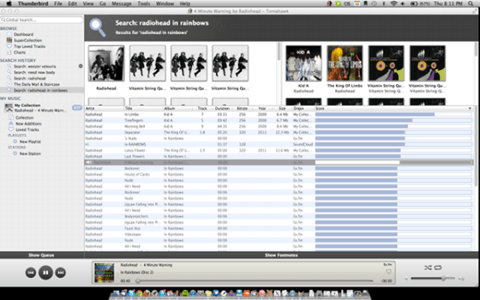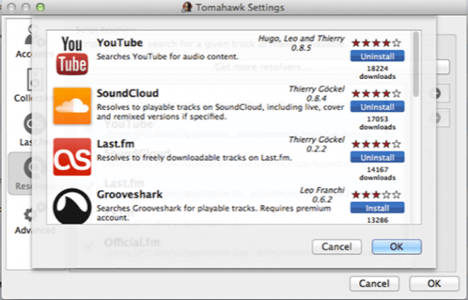Technology has done amazing things for music in the last decade. Sure, the large, traditional industry players are making less money, but there are now vastly more players, and the ecosystem that’s emerging looks pretty awesome.

Despite all the music streaming services and startups out there, there still exists a major problem: Each one is its own little island of content, disconnected from the rest. This leaves the user in the unfortunate position of having to hunt and peck around the Web to find different music.
No matter how hard it tries, no one individual digital music service is ever going to have a 100% comprehensive library. There are complex rights licensing issues, high costs and hesitant artists, for starters.
Meanwhile, the number of artists is exploding as old structures crumble and record labels become less relevant. A band you’ve never heard could be recording an album you’re going to love right now and upload it to SoundCloud next week, with or without the help of a label. The video they post on YouTube could be so well-crafted that it goes viral and lands in your Facebook news feed next Tuesday. This is the new radio.
The proliferation of streaming services, aggregators and apps for music is great. That doesn’t necessarily mean the experience is convenient for the user. To check out a new band I just heard about, I often have to jump from one service to another to find its music.

Tomahawk: An Infinite Music Library
This is precisely the problem that Tomahawk aims to solve. So far, it’s doing a phenomenal job of it. To get an idea of what Tomahawk is, imagine if iTunes not only scanned your hard drive for MP3s, but also let you plug YouTube, SoundCloud, Spotify, ex.fm and a number of other digital music services into it.
That’s Tomahawk. It’s open source and completely free to download and use on both Macs and PCs.
“I have the rights, and ability, to access content from a large number of sources – yet no single interface that lets me easily do so,” writes Jason Herskowitz, a digital music entrepreneur and contributor to the Tomahawk project. “Imagine a world where we share music metadata, and the logic of how that audio gets rendered is determined by the consumer of the data, not the sharer.”
Last.fm comes close to bridging the various gaps between services, but only in terms of music recommendations. For actual consumption of music, there’s never been a universal player that spans them all. Now there is.
When you run a search for an artist in Tomahawk, it looks through your personal collection, plus everything hosted on whatever Web-based services you plug into it. Spotify and Rdio boast several million tracks apiece. That’s nice. Tomahawk puts an infinite selection of music into a single interface.
From Local Acts to The Beatles, It’s All There
Last weekend, I saw a local, up-and-coming band from Philadelphia called Creepoid play a really great set during an all-day festival. The band was recently signed to a small label, so their stuff isn’t yet available via my premium Spotify account, save for one song. They do, however, have tracks up on ex.fm and SoundCloud, as well as a few videos on YouTube.
Now, ultimately, what I should do in this case is pay actual dollars for the album on vinyl – and I totally will, I swear – but in the meantime, if I want to hear some of their music, Tomahawk makes it very, very easy to do so without going on a wild digital goose chase.
On the other end of the spectrum, there’s The Beatles. Yes, those ever-stubborn digital holdouts. Their material finally landed on iTunes in 2009, six years after Apple’s now all-mighty online music store launched. It’s unlikely we’ll see their catalog roll out to the all-you-can-stream services anytime soon. I thankfully own all of the band’s albums in high-quality digital format stored on my laptop’s hard drive. Tomahawk knows this and automatically includes those tracks in my collection.
Every artist – from the band you saw perform at a bar last weekend to The Beatles – can be played from the same iTunes-style UI. If the band has recorded anything and posted it pretty much anywhere online, it’s here.

Whereas most online music services struggle with social integration, Tomahawk’s effort is a valiant one. You can hook it up to your Google and Twitter accounts to share with friends there, and the app itself allows you to access the libraries and playlists of people on the same network P2P-style.
The social features could be deeper overall. For instance, I’d love to be able to follow a user on SoundCloud if I come across one of their shared tracks in Tomahawk. Still, it does social much better than a lot of music apps out there.
As with any music app worth trying, you can scrobble listens to Last.fm, which is noteworthy because it opens up scrobbling functionality to a wide range of online services that may not support it natively.
Not Without Its Drawbacks
Because Tomahawk scrapes the depths of sources like YouTube, Grooveshark and SoundCloud, there’s much more here than just commercially released studio recordings. You can also stumble across live tracks, demos and covers, some of which are delightful finds.
This can also lead to undesirable results in some cases. For example, Tomahawk says it has John Lennon’s “Imagine” album, but what it really has is a collection of covers, demos and official studio versions of each track, albeit in the correct order. This could be interesting for a superfan, but it’s not the actual album and will probably disappoint the average listener. In a case like this, it’s better to own the album as an MP3 or another locally stored digital format.
To add third-party sources like SoundCloud, YouTube and Spotify to Tomahawk, you need to go into the app’s preferences and install what it refers to as content resolvers. Spotify and Grooveshark require premium accounts to work, but everything else is free to use. Unfortunately, Rdio and MOG are not supported.
Tomahawk is an open source project in beta mode, so it experiences the occasional hang up. By and large, it functions pretty smoothly, especially considering what it’s doing under the hood. As long as you have a solid Internet connection, it plays back music from a wide variety of sources pretty seamlessly.










